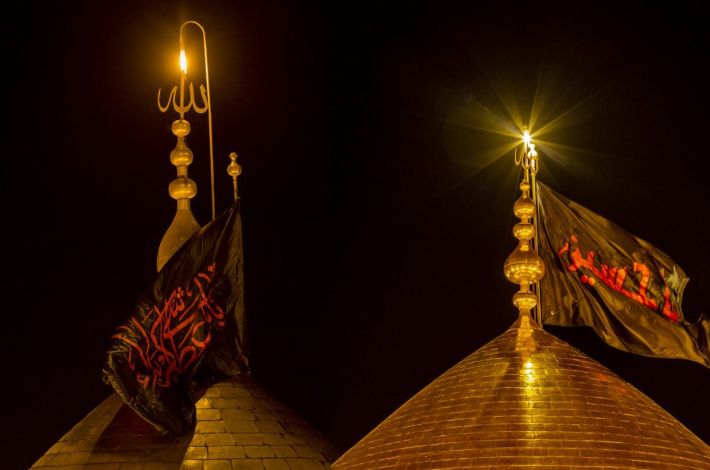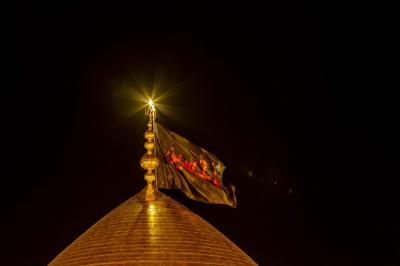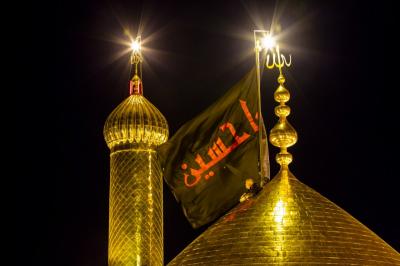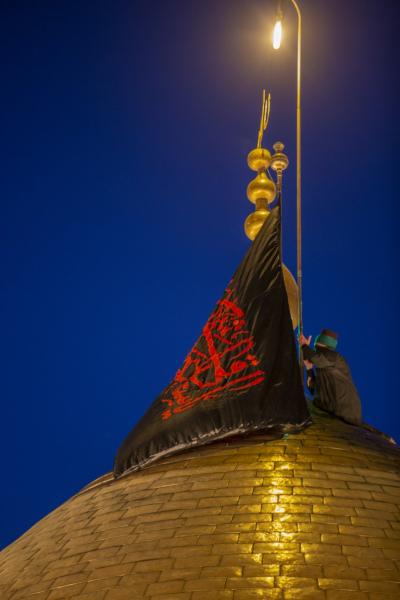The lessons of the great Hussaini renaissance and its heroic epic are renewed annually at the start of the month of Muharram, this month in which Iraqi traditions decided that the red flag above the dome of the shrines of Imam al-Hussayn and his brother al-Abbas (peace be upon them) would be lowered and replaced with a black one marking the start of the ritual remembrance of the tragedy in the midst of an atmosphere dominated by sadness, grief and anguish.
For many centuries, the ritual of changing the flag has been conducted normally by the administration of each shrine separately, and the replacing process is almost imperceptible and unknown to many, as people are surprised by the change of the two flags minutes after the beginning of the month of Muharram minutes after the Maghreb prayer, especially in the decades of dictatorship, when there was restrictions on any ritual movement.
However, the administrations of the Imam al-Hussayn and al-Abbas holy shrines, after the believers had breathed in the air of freedom with the fall of dictatorship, decided that these rituals should be of prestige and impact on the souls, to draw the world's attention for this month in which the greatest epic took place that changed the course of history and preserved Islam for thousands of years until God inherits it. Then, the flags' replacing process included also a group of Hussaini activities, such as poems, elegies and words of preaching in the midst of crowds of hundreds of thousands of visitors in recent years, interspersed with ritual music and military choirs of the Iraqi army, and other matters that magnify the importance of this occasion.
The first flags' replacing ceremonies began on a liturgical level, starting with Moharram 1426 AH corresponding to February 2005, and the participation in this ceremony was limited and simple with a few dozen believers.
And this ritual continued since its inception in that year until Moharram 1441 AH, with a great increase in attendance and diversity in activities, until the number of participants reached hundreds of thousands of believers in that year corresponding to 2019.
And because millions participate in this ceremony and its crowding is a danger to the health of visitors amid the spread of the Corona epidemic, and thus for their safety, in accordance with the instructions of the Ministry of Health and the World Health Organization, and according to the directives of the supreme religious authority for the establishment of the Husseini rituals while preserving the health instructions, for all this, the participation and rituals were reduced in this Moharram 1442 AH corresponding to (20/8/2020) similar to the early years, including the process of replacing the flags of the two domes, while listening to the immortal poem (O Shahr-e Ashour) of the late Radood Hamzah al-Saghir, and the turning off of the white and green lights in the holy shrines of Imam al-Hussayn and of al-Abbas (peace be upon both of them) and between the two shrines and the streets leading to them and lighting up the red lights.
The red flag indicates that the owner of this grave was killed and his revenge was not taken according to the prevailing Arab custom, while the black flag indicates sadness and consolation, and every year the red flag is lowered and replaced with a black one and remains until the first of Rabi’ Awal, when the red flag is returned.
Historians mention that the first to raise a red flag was a sheikh of the Bani Asad tribe, and after the al-Mukhtar al-Thaqafi built the first shrine of Imam Hussayn (peace be upon him), the red flag was raised above his dome, and it has been in existence since that time and is renewed every year.





